So far we have mostly focused on theoretical means for producing a visual of cinema standard against a budget image. We explored the theoretical pillars of non-fiction film like the basic tendencies of the documentary genre and the breakdown of a scene. We also covered visual film-making techniques such as movement, light and colour. Our motivation for looking into these topics was to broadly understand the medium at hands; to understand what we want to tell and how we can tell it; as efficient and beautiful as possible. So that we can strip down and dissect this understanding for application not only within boundless cinema-budget equipment but also in more limited environments.
4.1 | Story & Cinema
For sure, the complex essay text from the previous chapters as in its current state, is not going to be applied in low-end film making. Simply because there would be no time and money to work out such complex ideas to practical moves in a tight schedule.
However, with a bit of creative thinking, applying new ideas can become an exciting and fun process. We need to repackage discussed matter to something short, sticky and easy in use to motivate creative thinking processes. The idea is to design a product which will offer all the theoretical conduct on a small serving plate to it’s user. Not through the current text-book format but through interactivity and creativity.
I dissected and grouped the information to fit a small tabloid. The earlier conducted narrative study on non-fiction work will be referred to through 9 ‘story cards’, and the study into cinematography and visual design by 12 ‘cinema cards’. These cards can be interacted with during the planning of a media production in a game-like manner. The cards will help to access complex information and to apply creativity in the constructing process of a visual look and story, without stealing too much time.
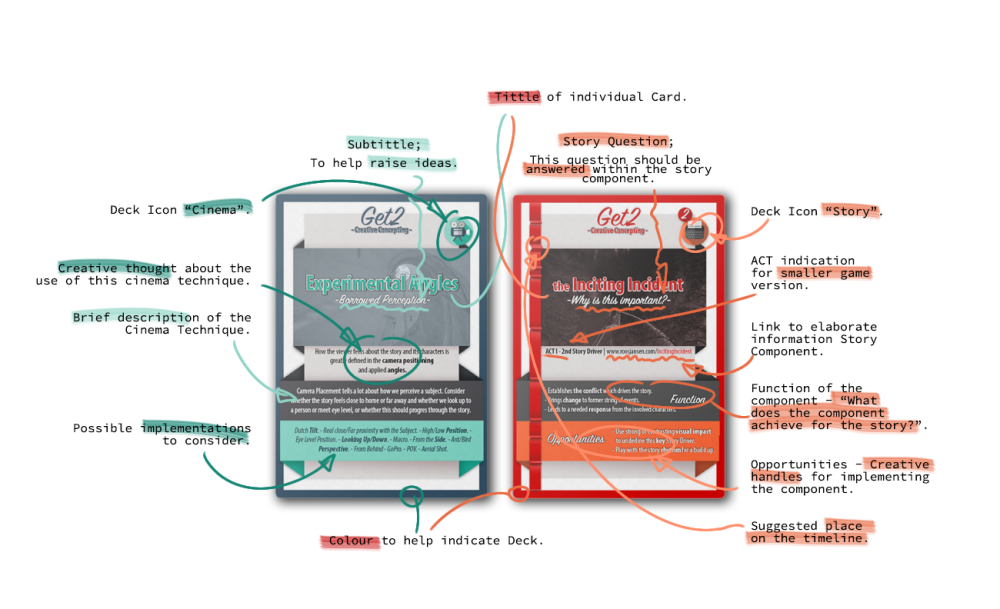
I have chosen for a card design so that the cards can be used as simple cheat-sheets, but even better through a little ‘Game of Cards’. After all gamification helps to relax the mind by introducing a playful tone to the task at hand, which favours our creativity. Interactive gameplay also helps acquire new skills and to motivate.
4.2 | Usability & Experience
The Get2 Game of Cards exists of 2 sets: the Story Cards and the Cinema Cards. The cards are to be applied after having received a first Production Briefing and help create the Concept Proposal for the client & crew.
The Story Cards are your first move in the Get2 game of cards. This 9-cards deck is to be seen by the player, who can freely choose the Story Components the video needs (a minimum of three). Choosing Story Components help the user to apply Story Structure to the script or video concept. Each individual Story Card contains a Story Driver, an action or decision which drives the story rhythm, allowing the narrative to move forward or find closure.
STORY DECK | Consists of: 9 Cards [ 3x 3 Arcs] Each Card Includes:
-Place of Story Driver on Timeline.
-Brief Explanation of the function.
-Opportunity for thinking direction.
-The question which the Story Driver answers.
-Option: QR code to inspiration log.
The Cinema Cards are designed to add visual interest to the production. This is done by assigning a visual attribute to each Story Component. The 12 cards are to be shuffled and randomly assigned. Matching one Cinema Card with each Story Card on the table. Once the matches are made, it is up to the user to find creative means of making the match work. Each individual Cinema Card contains creative handlebars to help guide the user in the brainstorming process. The card also addresses a short description of the Cinema Technique and possible implementations.
CINEMA DECK | Consists of: 12 Cards [] Each Card Includes: -Creative thought about the use of the Cinema Technique. -Possible implementations to consider. -Sub tittle to help raise ideas. -Brief description of the Cinema Technique. -Option: QR code to inspiration log
4.3 | User Testing Plan
The current Game of Cards is not necessarily the end product. The current product contains all hypothetical information and interaction for the end product to contain, but whether a Game of Cards is the most efficient medium for application has yet to be tested.
To verify the product concept a paper prototype has been printed. The prototype will be used during an assessment type observational usability test, followed with a brief interview. At the end of the User Test Experience we will asses the outcome of the creative concept through the COCD box.
The Goal of the User Test is to figure out whether the designed Get2 product is a welcome way of enhancing creative processes during the concepting phase of a Low-End production. To best test whether the current product type adds value, focus during the observation will be on:
- Clarity of the interaction.
- User friendliness of the provided tools.
- Mood during the interaction (fun, excited, curious, enthusiasm).
4.3.1. | Where, How and Whom?
The test will be held at the 1Camera office, which is the usual environment for the participants to be planning a production. To test the product, a hypothetical Product Brief & Soft Script will be provided, as well as a short description on how to use the Game of Cards. To help determine who our test participants are, a Persona has been created. The test participants have been selected by their specialisation and to best match the Persona characteristics.
The test participants specialise in Camera Operation (1x), Creative Production (2x) and Head of Production (1x). The product is originally designed for the Creative Production specialists, however, for testing purposes it is interesting to see how someone more visual (Camera Operator) as well as someone less familiar with Product Proposals (Head of Production) interacts with the product.
To better know the potential audience, the Customer Empathy Map is used. The map helps determine how potential costumers think, feel, hear and see.
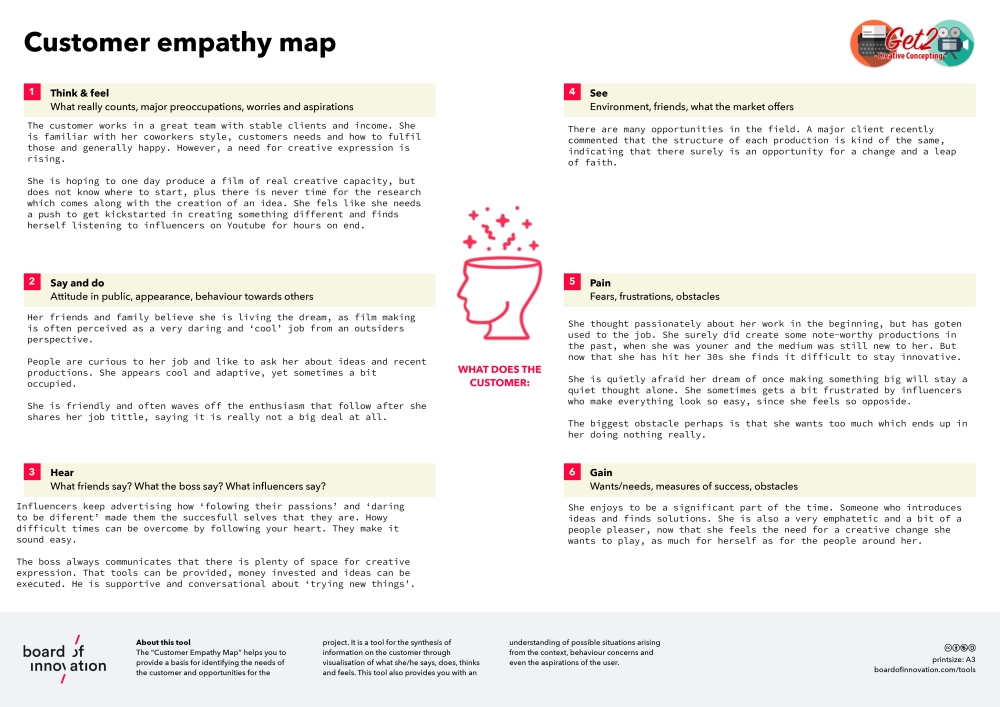
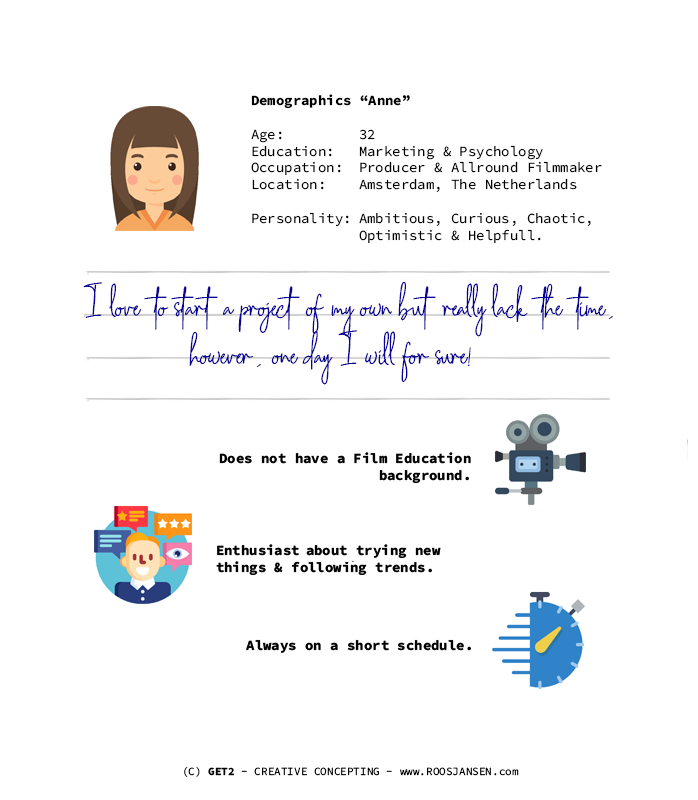
4.3.2. | The hypothetical Case
For the hypothetical video production a Product Brief is presented. The brief is designed to match the Low-End “Lite” Productions; through a late-notice phone call with little information and minimal creative demands.

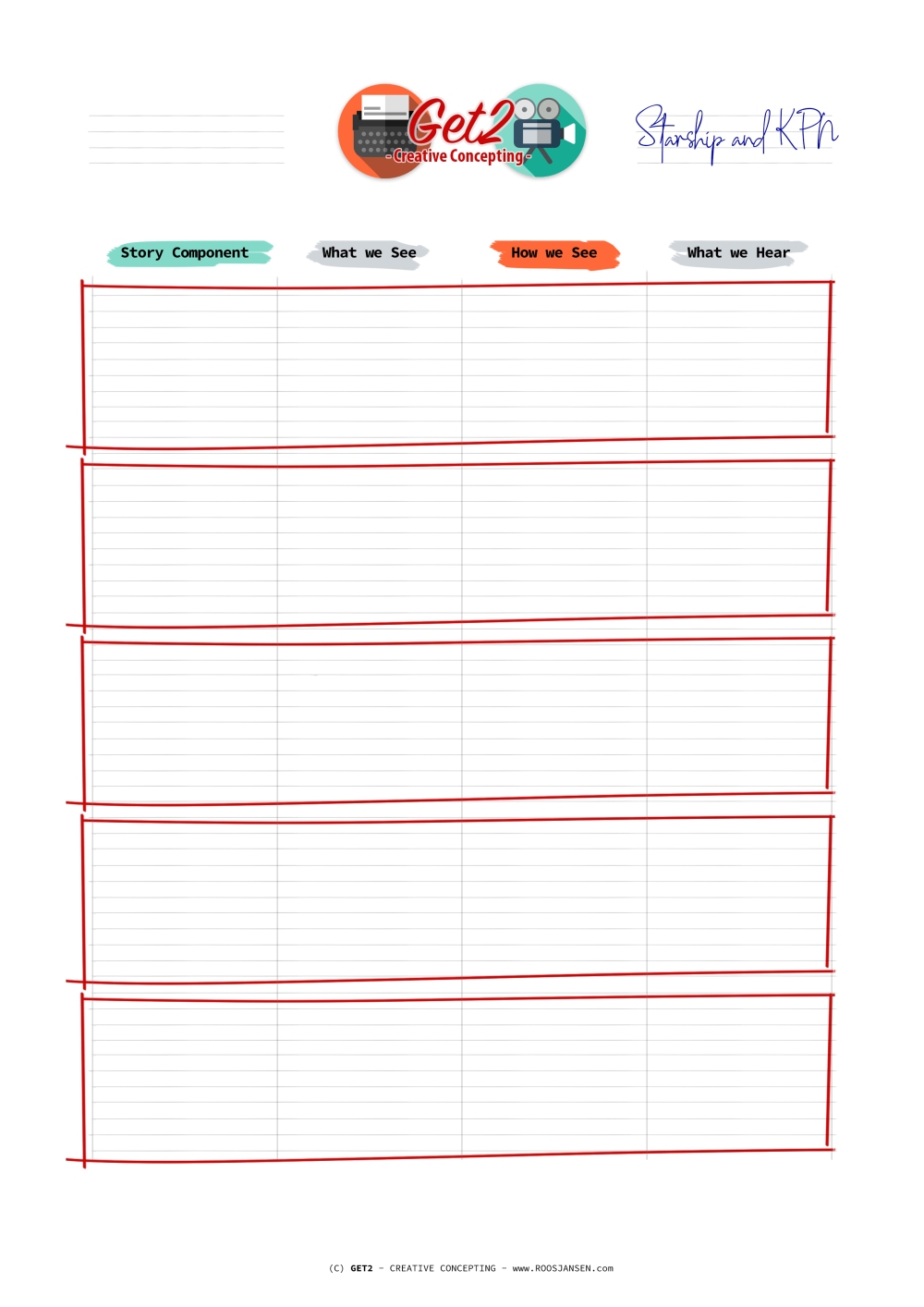
Next to the Product Brief & Project Proposal Schedule, the participants will receive a tutorial on how to interact with the Game of Cards, so that my influence during the test can be kept at an absolute minimum.
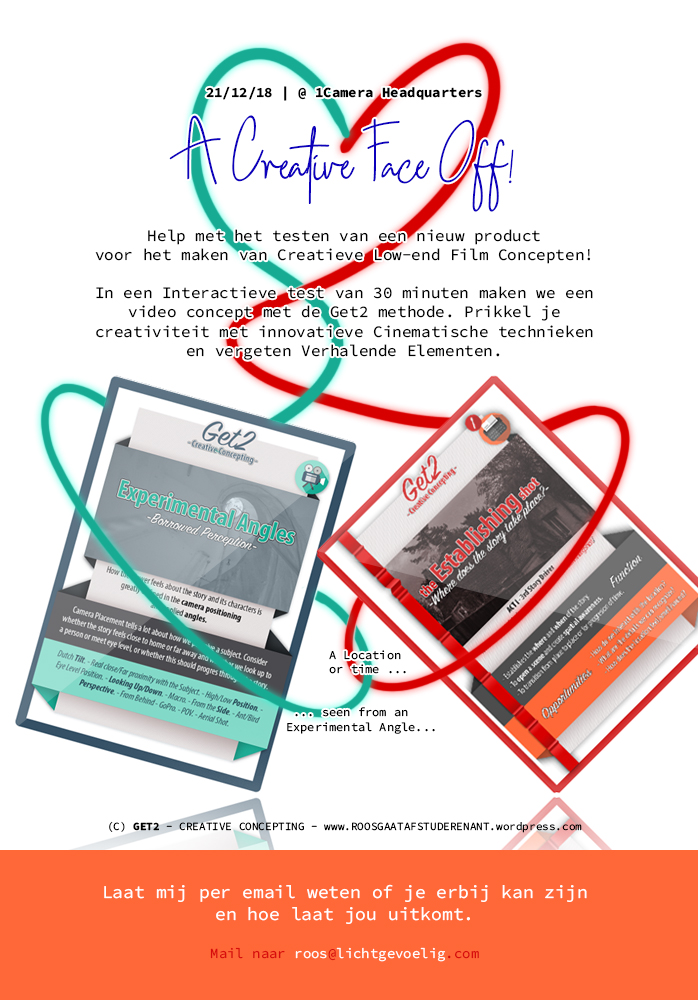
4.4 | Questions & Hypothesis
After the assessment type observational usability test, we will follow-up with a few interview questions. The aim of the interview questions is to better understand the perceived clarity of the experience, whether any information is missing or overly present and to gain opinion on the creative qualities* of their production proposal. At last the participants will be questioned about digital opportunities for the product, as of currently this part of the product has yet to be explored more.
*Challenges
Since creativity is such an extremely multifaceted quality, it is as of yet difficult to measure scientifically. However, since this research depends a lot on the value and growth of applied creativity, a measure should be conducted to verify the effects of the Get2 design. Therefore the “four Ps” by Mark Batey, a subjective measure, generally used in psychology to examine aspects of creativity, shall be applied. This method is by no means a scientific consensus, but as of yet more clarity on research techniques for the measurement of creativity has yet to be conducted.
The interview questions:
- [1st P – Cognitive Process Element] | How did you feel using the product?
- Creativity will be verified through an answer which reflects elements of improvement, innovating, insightful or imaginative.
- [2nd P – Personal Element ] | Did you learn something new during your interaction with the Get2 product?
- Creativity will be verified through an answer which reflects having learned new abilities/found new insights as positive.
- [ 3rd P – Product Element ] | What do you feel about the proposal you created?
- Creativity will be verified through an answer which reflects elements of surprise, originality, utility and beauty.
- [ 4th P – Press/Environment ] | How did you find the use of a Card Game for crafting a concept proposal?
- Creativity will be verified through an answer which categorizes the card game as prohibiting/conducive to the creative process.
- Could digital tools enhance this product? In what way?
- Do you have any suggestions/recommendations?
4.5 | Final Updates for the Testing Day
Update #1 | Playing Cards
After testing the Product myself I made a few small changes to the product design. Firstly, after printing I found the readability of the cards challenging, so I upscaled the cards to 120% of the original size and reprinted the product. Secondly, I changed the card number from the Component number to the ACT number. This way the game can be played with less cards ( a minimum of 3, 1 per ACT ) which makes the experience more free and allows for more choice (cheaper, smaller productions) which I found welcoming during my test. And at last I updated the web link given on the card. The updated web links are now obtained in the web blog, containing extended information to the subject of the card such as creative examples, ideas and explanation.
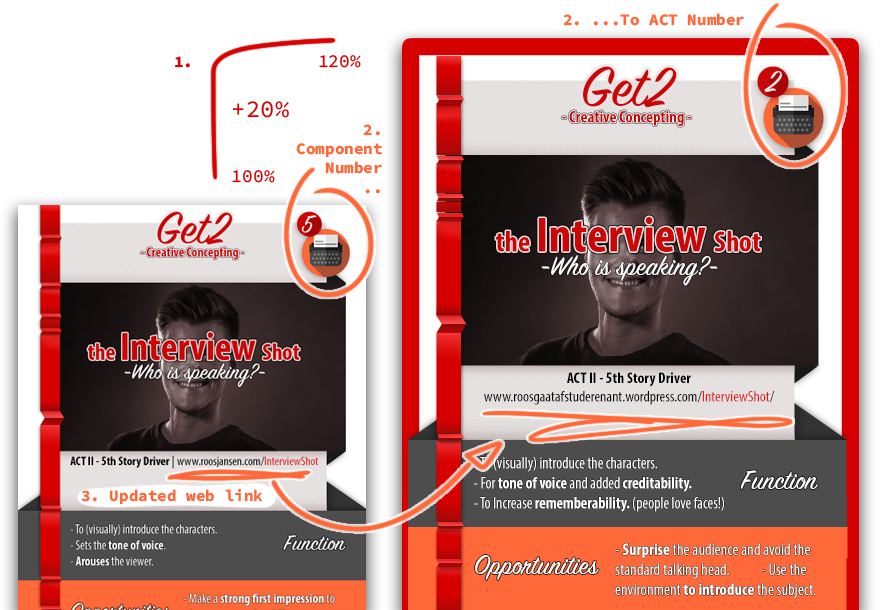
Update #2 | Additional information Soft Script
I had also decided to fill in the “What you See” and “What you hear” column
of the Soft Script before the test to avoid time being spend on an activity the participants are already familiar with.
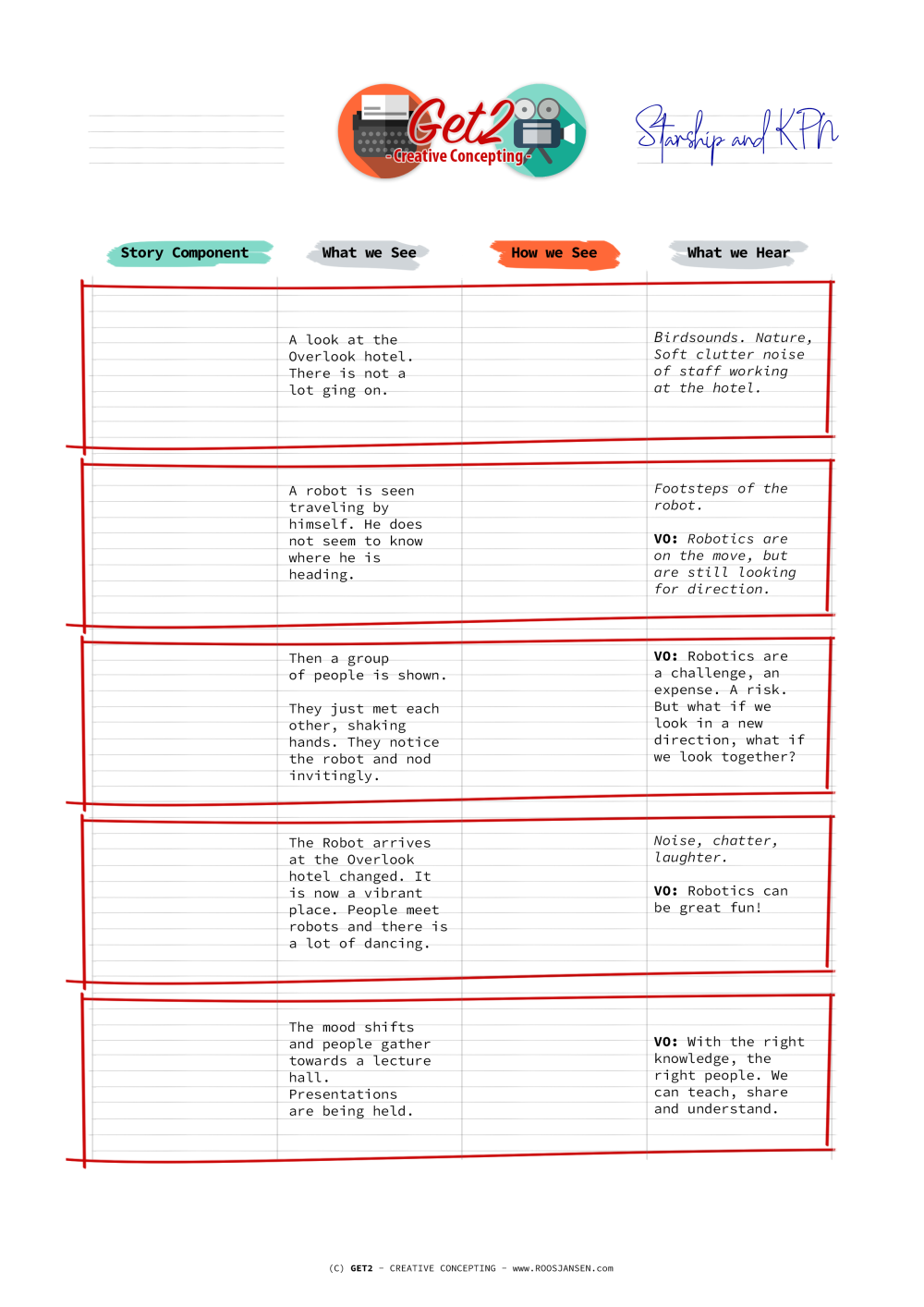
-
Update #3 | Playful explainer cards
I finalised the ‘How-to-Play’ cards to have a visual, engaging explanation on how to interact with the cards. This way my interventions can be kept at a minimum during the tests.
– Summing-up Sub-Question 4 –
How to make the implementation of narrative and visual techniques more routine?
To translate complex ideas to practical moves, text-book format conduct has to be replaced by interactivity and creativity. A system has to be designed which uses and introduces narrative and visual concepts and applies those in the root-system of production planning. In the case of 1Camera, this means an adaptation to their current production planning with the Soft Script.
For this, a Creative Concepting method called ‘Get2‘ has been designed. This card-game based method introduces mature techniques in a playful manner, daring the user to construct creative ideas through interactive match making and a fresh look. Applying gamification to challenge creativity and to learn new techniques.
To find out whether the developed plan makes the implementation of narrative- and visual techniques more routine and fun, an observational usability test is developed. A hypothetical case will be presented to different film-industry specialists, for which a production planning has to be developed using the Get2 method.
After the observational usability test a short interview shall be conducted to discover whether the designed Get2 method leads to application of creativity. The amount of creative thinking will be validated through categorization of the answers within the four Ps stakeholders. An additional question should help explore what potential for digitalisation could be implemented.